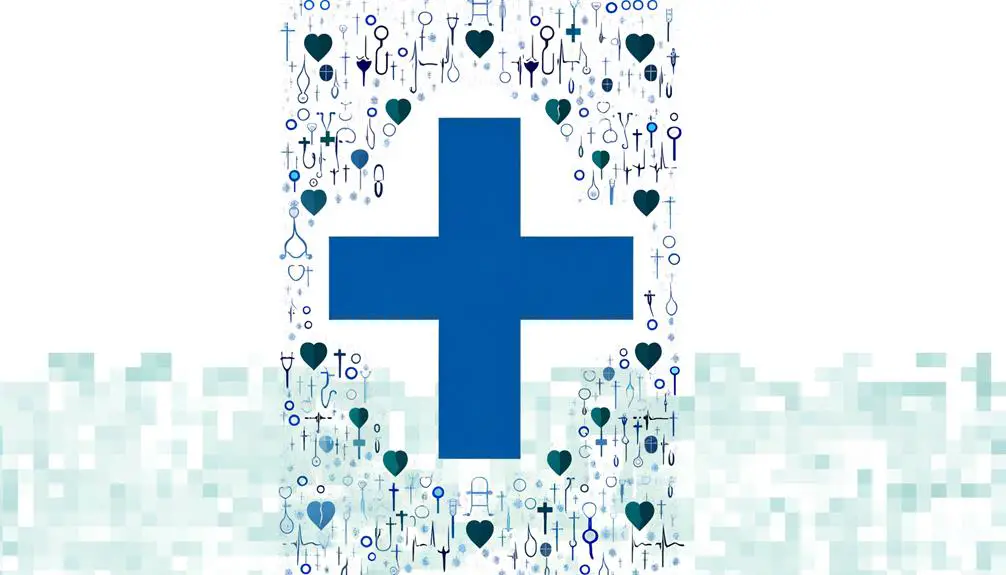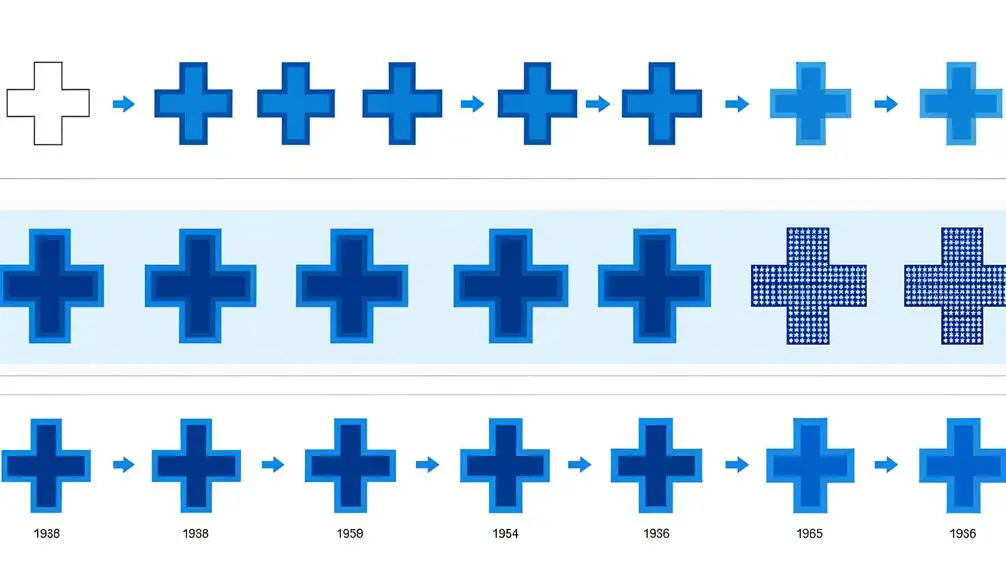What Is the Meaning of the Blue Cross Symbol?
The Blue Cross symbol originated in the early 20th century, introduced by Baylor University Hospital in 1929. It represents trust and reliability in healthcare, symbolizing a commitment to compassionate, dependable medical services.
The blue color signifies a tranquil and trustworthy experience, while the cross conveys a promise of healthcare excellence. Over time, the design has evolved to enhance visual appeal and communicative clarity, reflecting contemporary trends and technological advancements.
Globally recognized, the Blue Cross symbol bridges cultural and geographical divides, fostering a cohesive healthcare infrastructure. To fully understand its impact on patients and healthcare, further details are available.

Key Takeaways
- The Blue Cross symbol represents trust and reliability in healthcare services.
- It signifies a commitment to providing compassionate and dependable care.
- The blue color conveys a tranquil and trustworthy healthcare experience.
- The cross embodies the promise and ethos of healthcare excellence.
- The symbol is globally recognized, fostering cross-cultural understanding in healthcare.
Historical Background

The Blue Cross symbol, which has become synonymous with healthcare and insurance, traces its origins back to the early 20th century, marking a pivotal shift in the landscape of medical services.
Initially adopted by hospitals in the United States to signify pre-paid health plans, the symbol emerged in response to the financial strain of the Great Depression. Baylor University Hospital in Dallas, Texas, pioneered the first Blue Cross plan in 1929, offering teachers a subscription-based service to cover hospital costs.
This innovative model rapidly gained traction, leading to the formation of the Blue Cross Association in 1939.
Symbolic Significance

Representing trust and reliability in healthcare, the Blue Cross symbol encapsulates a legacy of assurance and stability for individuals seeking medical services.
This emblem is not merely a logo but a representation of a promise that healthcare providers aim to uphold. The blue color, often associated with calmness and professionalism, signifies a tranquil and dependable healthcare experience.
The cross, universally recognized as a symbol of aid and support, conveys the commitment to providing all-encompassing and compassionate care. Together, they form a powerful icon that reassures patients of the quality and consistency of the services they will receive.
The symbolic significance of the Blue Cross extends beyond aesthetics, embedding itself into the very ethos of healthcare excellence and patient trust.
Design Evolution

Tracing the design evolution of the Blue Cross symbol reveals a fascinating journey of visual transformation that reflects shifts in both aesthetic preferences and organizational values. Initially characterized by a simple blue cross on a white background, the symbol has undergone numerous modifications to enhance its visual appeal and communicative clarity.
Over the decades, elements such as color shades, cross dimensions, and accompanying text have been meticulously adjusted. These changes were driven by the need to remain contemporary while ensuring the symbol's recognizability and trustworthiness. The symbol's adaptations also mirror broader design trends and technological advancements, indicating a strategic alignment with evolving user expectations and branding standards.
Each iteration has contributed to fortifying the symbol's identity and purpose.
Global Recognition

The Blue Cross symbol has achieved global recognition as a universal representation of healthcare services, transcending geographical and cultural boundaries. Its widespread adoption underscores its role in fostering cross-cultural understanding, ensuring that individuals worldwide can easily identify and access medical assistance.
This universal applicability highlights the symbol's effectiveness in bridging diverse healthcare systems and promoting a cohesive global health infrastructure.
Universal Healthcare Symbol
Recognized globally, the Blue Cross symbol serves as a universal emblem for healthcare services, providing an easily identifiable mark that signifies medical assistance and insurance coverage. This symbol's widespread adoption underscores its importance in the healthcare sector. Its universal recognition is attributed to several factors:
- Standardization: The Blue Cross symbol offers a consistent and reliable indicator of healthcare services, making it simpler for individuals to locate medical assistance.
- Trust and Credibility: Over time, the symbol has come to represent quality and reliable healthcare, fostering trust among patients and providers alike.
- Accessibility: The simplicity of the symbol ensures it is easily understood across diverse populations, reducing barriers to accessing care.
This emblem's universal nature plays an essential role in promoting global health equity.
Cross-Cultural Understanding
Building on its role as a universal healthcare symbol, the Blue Cross's global recognition is further enhanced by its ability to transcend cultural and linguistic barriers. Its simplicity and clarity make it easily identifiable across diverse populations, ensuring its message of medical care is universally understood.
The emblem's design, commonly associated with aid and health, aligns with the culturally ingrained meanings of the cross symbol in many societies. This widespread acceptance facilitates seamless communication in multinational contexts, from international aid organizations to global healthcare providers.
As a result, the Blue Cross serves as an effective tool for conveying critical healthcare information, fostering trust, and ensuring consistency in health services across different regions of the world.
Blue Cross in Healthcare

Widely acknowledged as a cornerstone in the healthcare industry, the Blue Cross symbol represents a legacy of providing accessible and thorough health insurance coverage. Founded during the Great Depression, Blue Cross organizations have grown to become integral to the American healthcare landscape.
The symbol signifies:
- Trust and Reliability: It is synonymous with dependable health insurance services.
- Comprehensive Coverage: It encompasses a wide array of medical services, from preventive care to complex treatments.
- Community Focus: Originally established to ensure hospital access for teachers, it continues to prioritize community health needs.
This emblematic representation has evolved to embody steadfastness in the provision of quality healthcare. The Blue Cross symbol not only marks a historical journey but also underscores ongoing commitments to public health.
Impact on Patients

The Blue Cross symbol's historical significance and commitment to community health translate into tangible benefits for patients, impacting their access to quality care and overall health outcomes.
Patients under Blue Cross plans often experience reduced financial barriers, leading to increased utilization of preventive services and timely medical interventions. This enhanced access promotes early detection of illnesses, enabling more effective management and potentially reducing long-term healthcare costs.
Additionally, the consistency and reliability associated with the Blue Cross brand foster patient trust, encouraging adherence to treatment plans.
Furthermore, Blue Cross's extensive network of providers guarantees continuity of care, which is critical in managing chronic conditions.
Ultimately, these factors collectively contribute to improved patient satisfaction and better health outcomes.
Conclusion
To sum up, the Blue Cross symbol has evolved from its historical roots to become a globally recognized emblem in healthcare. An interesting statistic reveals that over 100 million people worldwide are covered under Blue Cross healthcare plans, highlighting its significant impact on patient care.
The symbol's design evolution and its widespread acceptance underscore its importance in ensuring access to quality healthcare services, thereby affirming its enduring relevance in the medical field.






